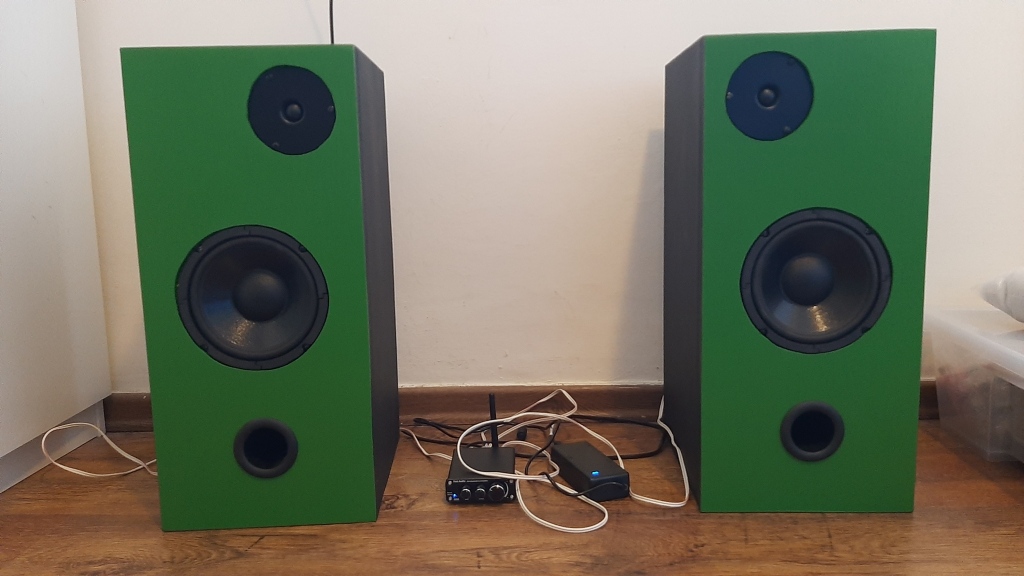A few years ago I started getting into the world of speaker building. I knew nothing about it but I had the passion and I wanted to start building. I decided to start with something simple, without reading too much about it. I followed the “what could possibly go wrong” approach and I thought I could dive into it without learning too much. Apparently, I was wrong…
The design process
I wanted to start with a basic 2-way speaker. I bought the following 6-1/2″ woofer: Dayton Audio DC160-8 and the following 3/4″ tweeter: Peerless D19TD05-08. I realized I needed a port and a crossover so I bought an off-the-shelf port and and an off-the-shelf 2nd order crossover that crosses at 2 KHz (big mistake, the port and the crossover should never be generic…)
I used 19mm MDF for the construction and 24mm MDF for the baffle (good choices apparently). The overall cabinet size was something like 25 litres, which wasn’t so bad either.
Here’s how it looked after I built it:

A bunch of mistakes…
Here’s a short list of the mistakes I made in the design and build process of these speakers:
- The tweeters and the woofers don’t cover the entire freuency range. Looking at the reference manual of these elements, the frequency range of the tweeter doesn’t go low enough and the frequency range of the woofer doesn’t go high enough. Specifically, the tweeter works best at 2 Khz – 20 KHz and the woofer works best at 50 Hz – 1KHz. This leaves a serious gap for a two-way speaker.
- The distance between the woofer and the tweeter is too long. The elements should be much closer to each other, especially when the crossover frequency is as high as 2 KHz.
- Regardless of the distance between the elements, the tweeter’s location is bad because its distance from the upper wall is the same as its distance from the nearest side wall. This creates unwanted resonances which are hard to eliminate with filters.
- Using an off-the-shelf port is bad, especially if you don’t modify its length. Before designing my next pair of speakers I learned that the port length and diameter should match the speaker’s specifications and the cabinet size. A design tool like WinISD is recommended to find the right port length that matches the speaker and the cabinet. This makes a huge difference, especially in the low frequency range.
- Using an off-the-shelf crossover is bad. It doesn’t take into account the specific frequency response and impedance curve of each speaker, and it also doesn’t take into account the baffle width, so the baffle step cannot be compensated for.
- No attenuation on the tweeter. According to the specs, the sensitivity of the woofer is 86.1 dB and the sensitivity of the tweeter is 91.3 dB. This means the tweeter is going to play much louder than the woofer. The way to compensate for that is either to attenuate the tweeter using an L-pad or to use more woofers (e.g. by using an MTM configuration)
I still did something right…
I’ve built a few more speakers since then. In retrospect, here’s a few things I did get right, even with my first set of speakers:
- Thick baffles. Almost all the speakers I built since then have a thick baffle, usually in the range of 24mm – 32mm. Thick baffles help a lot when you screw the speakers to the baffle. They also provide a warmer and richer sound in my opinion. The downside of thick baffles: they’re heavy. But then again, heavy speakers is a good thing in my opinion. Also, the rest of the cabinet’s walls don’t have to be that thick so the weight of a thick baffle is not that high.
- Front-firing port. It’s debatable, but I like it. Placing the port on the front helps when you place the speakers in the room. It allows you to place the speakers closer to the wall and still maintain a good bass extension.
- Wide woofers. I like a deep bass and the minimum woofer width I allow myself is 6″. I wouldn’t recommend less than that.
A list of tools
Here’s a list of tools and tutorials I used after I realized I made these mistakes. The tools listed below can help designing better speakers, avoiding the basic mistakes I made:
- WinISD – a tool for choosing the cabinet size and port length for specific drivers
- WinISD tutorial: https://youtu.be/yZNeYBYGRKk
- Baffle Diffraction and Boundary Simulator – a tool for choosing the placement of the drivers on the baffle, minimizing resonances and nulls caused by improper placement
- A measurement microphone. I bought the umik-1. Other microphones can also be used. Here’s a short tutorial I recommend about measurement microphones: https://youtu.be/AKArv5Jhymc
- Measurement software: https://www.roomeqwizard.com/
With these tools, I was able to properly design and build the next pair of DIY speakers, which already sounded a lot better. I was able to properly design the cabinet and build the port that matches the cabinet and the woofer. Then I was able to make measurements of each one of the elements in order to design the crossover.
More on that in the next posts…